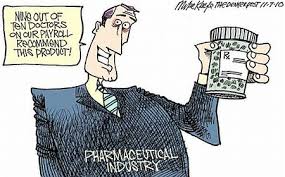Your waitress wants you to get another round of drinks. We get it. She wants to sell more and boost her tip. But what if your doctor is doing the same thing when it comes to drugs? Unfortunately, they also want to sell more, and boost their tip… from the pharmaceutical companies.
But unlike the waitress, the doctor relies on a system of lies and manipulations. Some doctors don’t even know what they are caught up in. They perform the tests. They read the journals. The tests say you have a disease. The journals say what treatments work.
But too often the tests are designed by the drug industry. And the journals are written and reviewed by frauds.
The Tests
All of a sudden, everyone has a disease! What could have caused such a vast increase in hypertension, obesity, and osteoporosis? The answer is an expanded definition of who is considered afflicted.
You walk into your doctor’s office for a physical exam and step on the scale. Last year, the doctor said you were overweight. Now he says you are obese — at the same weight.
A nurse takes your blood pressure. You have hypertension — with the same previously healthy reading you’ve had for years.
The doctor scans your wrist bone. You have a condition called “osteopenia” — with the same bone density that was fine last time you were measured…
You are suddenly sick, simply because the definitions of disease have changed. And behind those changes, a Seattle Times examination has found, are the companies that make all those newly prescribed pills.
This is nothing new. Unfortunately, the above quotation is from the introduction to a 2005 series of articles. They were sounding the alarm early, but things have only gotten worse.
Back then, the pharmaceutical industry had a hand in designing the testing tools for osteoporosis. They helped change the definition of obesity. They redefined diseases without any strong evidence. And they did this by giving money to doctors in order to promote their agenda. Some of the doctors who received kickbacks were policy setters in the World Health Organization, the U.S. National Institute for Health, and other medical associations.
Every time the boundary of a disease is expanded — the hypertension threshold is lowered by 10 blood-pressure points, the guideline for obesity is lowered by 5 pounds — the market for drugs expands by millions of consumers and billions of dollars.
The result? Skyrocketing sales of prescription drugs. Soaring health-care costs. Escalating patient anxiety. Worst of all, millions of people taking drugs that may carry a greater risk than the underlying condition. The treatment, in fact, may make them sick or even kill them.
One woman was taking a medication to lower her blood pressure. When it was ineffective, the dose was doubled. This caused an allergic reaction which sent her to the hospital and could have been deadly. Her doctor switched her to other medications.
Her doctor, Saunders, doesn’t sound like some evil stooge taking back room bribes. He sounds like a man caught up in an industry in crisis. But Saunders isn’t sure whom to trust. He questions the stream of studies leading to new guidelines urging broader use of new medications.
“In my heart of hearts,” he said, “I am concerned that these studies that are telling people that it’s best to get down to 120 over 80 are all paid for by drug companies who are trying to sell pills. It makes me uncomfortable. I think the days of getting unbiased information are gone.”
But this is all old news. Most people have gotten a glimpse of such conflicts of interest. But still, doctors rely on the experts. Even if your local doctor is not corrupt and money hungry, he may be listening to people who are. And worse yet, he may be reading medical journals that are a complete fraud.
Hundreds of “Scholarly Articles” Retracted
The medical journal publisher Springer has retracted almost 200 papers in the last two years because “the peer review process was compromised.”
Sadly, many of the retracted articles have to do with tumor biology. For years, people have been labeled conspiracy theorists for believing in the massive amount of corruption surrounding the cancer industry. This retraction is just the tip of the iceberg.
The most affected journals are Tumor Biology (25 papers) and Diagnostic Pathology (23 papers). The other journals are Comparative Clinical Pathology (one paper), Journal of Parasitic Diseases (four papers), Cancer Cell International (two papers), Journal of Ovarian Research (two papers), and World Journal of Surgical Oncology (one paper).
To submit a fake review, doctors often provided false emails which came back to them or someone else they could trust to provide a great review and vouch for the accuracy of the paper. Many journals accept paid entries without doing the homework to find out anything about the person submitting the paper, or who allegedly peer reviewed the piece.
But even when the medical papers are not outright lies, they can be quite misleading. According to a JAMA review:
Of the 45 eligible highly cited studies with efficacy claims (Table 2), 7 (16%) were contradicted by subsequent research, and another 7 (16%) were found to have initially stronger effects. In all these 14 cases (Box 1), subsequent studies were either larger or better controlled (randomized vs a nonrandomized original study). The findings of 20 highly cited articles (44%) were replicated (also with a larger sample size in subsequent research compared with the original highly cited study) and 11 (24%) had remained largely unchallenged.
Basically, 66% of the highly cited studies could not really be trusted. There just was not enough evidence of their findings to take them as solid truth. 32% of the studies should have been ruled out altogether, since later better studies found the results incorrect or highly exaggerated.
Reaching a Crescendo
The evidence is mounting against the pharmaceutical industry’s influence on the medical community.
It seems like a good thing to focus on preventative care. What’s so bad about expanding the base of people considered at risk for certain diseases? The issue is that the drugs themselves can cause serious harm and side effects. Many have not been studied over the course of enough years to be accurately labeled as safe. Doctors are prescribing the drugs to younger and younger patients since the threshold for each illness, and who is at risk, has been lowered, with the influence of the drug companies.
And on top of all that, the studies and journals that are relied on for information about diseases and cures have been compromised. From false reviews to failure to replicate, the data is simply not as concrete as many doctors would have us believe.
The bottom line is that individuals need to take their health into their own hands. Sometimes, yes, it is right to take a prescription the doctor suggests. But your own thorough research should be done on the necessity, risks, and benefits of such medications.
When it comes to preventative health, many pharmaceutical drugs are derived from common herbs. Yet Great Britain’s National Health Institute has begun discouraging doctors from treating patients with inexpensive homeopathic and natural medicines. Go figure many of the doctors who made that decision do “consulting” work for the pharmaceutical industry.
The best thing to do is make every effort to avoid ever having to use mainstream medicine. Exercise and eating right is a good start.
And for herbal remedies to some common, and some serious, conditions, check out The Green Pharmacy by James Duke. You might find that ginger and pineapple are a better anti-inflammatory option than the stomach churning over the counter pills.








